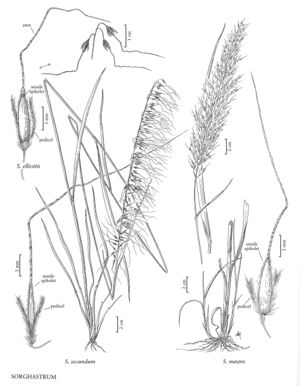Difference between revisions of "Sorghastrum nutans"
FNA>Volume Importer |
imported>Volume Importer |
||
| Line 16: | Line 16: | ||
-->{{Treatment/Body | -->{{Treatment/Body | ||
| − | |distribution=Conn.;N.J.;N.Y.;Wis.;Del.;D.C;Man.;Ont.;Que.;Sask.;W.Va.;Colo.;Fla.;Wyo.;N.H.;N.Mex.;Tex.;La.;Tenn.;N.C.;S.C.;Pa.;Va.;Mass.;Maine;R.I.;Vt.;Ala.;Kans.;N.Dak.;Nebr.;Okla.;S.Dak.;Ark.;Ill.;Ga.;Ind.;Iowa;Ariz.;Md.;Ohio;Utah;Mo.;Minn.;Mich.;Mont.;Miss.;Ky. | + | |distribution=Conn.;N.J.;N.Y.;Wis.;Del.;D.C.;Man.;Ont.;Que.;Sask.;W.Va.;Colo.;Fla.;Wyo.;N.H.;N.Mex.;Tex.;La.;Tenn.;N.C.;S.C.;Pa.;Va.;Mass.;Maine;R.I.;Vt.;Ala.;Kans.;N.Dak.;Nebr.;Okla.;S.Dak.;Ark.;Ill.;Ga.;Ind.;Iowa;Ariz.;Md.;Ohio;Utah;Mo.;Minn.;Mich.;Mont.;Miss.;Ky. |
|discussion=<p><i>Sorghastrum nutans</i> grows in a wide range of habitats, from prairies to woodlands, savannahs, and scrubland vegetation. It is native from Canada to Mexico and was one of the four principal grasses of the tallgrass prairie that occupied the central United States prior to agricultural development of the region. It is frequently used for forage, for erosion control on slopes and along highways, and in restoration work. It is an attractive plant and can be used to advantage in flower arrangements. It grows readily from seed if adequate moisture is available. There are several cultivars on the market.</p> | |discussion=<p><i>Sorghastrum nutans</i> grows in a wide range of habitats, from prairies to woodlands, savannahs, and scrubland vegetation. It is native from Canada to Mexico and was one of the four principal grasses of the tallgrass prairie that occupied the central United States prior to agricultural development of the region. It is frequently used for forage, for erosion control on slopes and along highways, and in restoration work. It is an attractive plant and can be used to advantage in flower arrangements. It grows readily from seed if adequate moisture is available. There are several cultivars on the market.</p> | ||
|tables= | |tables= | ||
| Line 34: | Line 34: | ||
|illustrator=Linda A. Vorobik;Annaliese Miller | |illustrator=Linda A. Vorobik;Annaliese Miller | ||
|illustration copyright=Utah State University | |illustration copyright=Utah State University | ||
| − | |distribution=Conn.;N.J.;N.Y.;Wis.;Del.;D.C;Man.;Ont.;Que.;Sask.;W.Va.;Colo.;Fla.;Wyo.;N.H.;N.Mex.;Tex.;La.;Tenn.;N.C.;S.C.;Pa.;Va.;Mass.;Maine;R.I.;Vt.;Ala.;Kans.;N.Dak.;Nebr.;Okla.;S.Dak.;Ark.;Ill.;Ga.;Ind.;Iowa;Ariz.;Md.;Ohio;Utah;Mo.;Minn.;Mich.;Mont.;Miss.;Ky. | + | |distribution=Conn.;N.J.;N.Y.;Wis.;Del.;D.C.;Man.;Ont.;Que.;Sask.;W.Va.;Colo.;Fla.;Wyo.;N.H.;N.Mex.;Tex.;La.;Tenn.;N.C.;S.C.;Pa.;Va.;Mass.;Maine;R.I.;Vt.;Ala.;Kans.;N.Dak.;Nebr.;Okla.;S.Dak.;Ark.;Ill.;Ga.;Ind.;Iowa;Ariz.;Md.;Ohio;Utah;Mo.;Minn.;Mich.;Mont.;Miss.;Ky. |
|reference=None | |reference=None | ||
|publication title= | |publication title= | ||
|publication year= | |publication year= | ||
|special status= | |special status= | ||
| − | |source xml=https:// | + | |source xml=https://bibilujan@bitbucket.org/aafc-mbb/fna-data-curation.git/src/bb6b7e3a7de7d3b7888a1ad48c7fd8f5c722d8d6/coarse_grained_fna_xml/V25/V25_1538.xml |
|subfamily=Poaceae subfam. Panicoideae | |subfamily=Poaceae subfam. Panicoideae | ||
|tribe=Poaceae tribe Andropogoneae | |tribe=Poaceae tribe Andropogoneae | ||
Revision as of 22:02, 27 May 2020
Plants rhizomatous, rhizomes short, stout, scaly. Culms 50-240 cm tall, 1.5-4.5 mm thick, erect; internodes glabrous. Sheaths glabrous or sparsely hispid; ligules 2-6 mm, usually with thick, pointed auricles; blades 10-70 cm long, 1-4 mm wide, usually glabrous. Panicles 20-75 cm, loosely contracted, yellowish to brownish; branches often flexible. Spikelets 5-8.7 mm. Calluses blunt, villous; lower glumes 5-8 mm, pubescent, 7-9-veined; upper glumes 5-8 mm, 5-veined; awns 10-22(30) mm, about 2-3 times longer than the spikelets, once-geniculate; anthers (2)3-5 mm. Caryopses 2-3 mm. Pedicels 3-6 mm, flexible. 2n = 20, 40, 80.
Distribution
Conn., N.J., N.Y., Wis., Del., D.C., Man., Ont., Que., Sask., W.Va., Colo., Fla., Wyo., N.H., N.Mex., Tex., La., Tenn., N.C., S.C., Pa., Va., Mass., Maine, R.I., Vt., Ala., Kans., N.Dak., Nebr., Okla., S.Dak., Ark., Ill., Ga., Ind., Iowa, Ariz., Md., Ohio, Utah, Mo., Minn., Mich., Mont., Miss., Ky.
Discussion
Sorghastrum nutans grows in a wide range of habitats, from prairies to woodlands, savannahs, and scrubland vegetation. It is native from Canada to Mexico and was one of the four principal grasses of the tallgrass prairie that occupied the central United States prior to agricultural development of the region. It is frequently used for forage, for erosion control on slopes and along highways, and in restoration work. It is an attractive plant and can be used to advantage in flower arrangements. It grows readily from seed if adequate moisture is available. There are several cultivars on the market.
Selected References
None.
